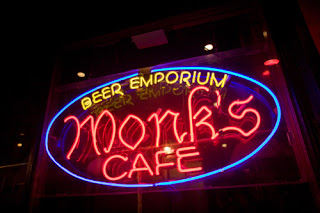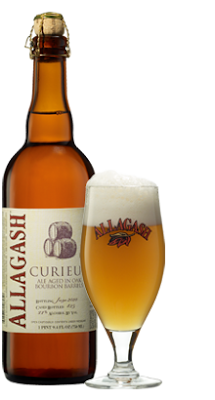Recently I was on a trip to Philly. The first thoughts that went through my mind were to get a good cheesesteak, go to DiNic's for a famous roast pork sandwich and pick up some Russian River beer. Well I got there to late to go to DiNic's, couldn't find a good cheesesteak place near me and I needed to go somewhere to get away from the smell. Lets just sasy that Philly smells intertesting . . . sorry Philly people. I pulled out my trusty phone and typed beer into the google maps search menu. After searching through options of places that only served beer for the masses I stumbled upon one called Monk's Cafe.
This rang a bell because I remebered having a sour beer by this name before. So my friend and I decided to give this place a try. After walking several blocks we finally found it. After figuring out how to get into the place, the door seemed lock but it turned out I just needed to be smarter than what I was working with, we took a seat at the bar and were greeted with a beer menu that was about 12 pages long. In contrast the food menu was 3-4 pages long and we actually had to ask for that one. The first beer on order was their flagship beer. It is a flemish sour ale brewed specifically for Monk's Cafe over in Belgium. It was absolutley amazing! Refreshing and crisp with a sour, almost vinegar, flavor to it but with a tatse sour cherries. It pours a dark brown with only a light floating head. This might seem like a little much for some of you beer drinkers but don't fear the sour. On a hot summer day this is just what you need. It is so thirst quenching that I actually had to stop my self from chugging several glasses in a row.
 Monk's Cafe Flemish Red turned out to not be the only gem that I found that night. I am a huge fan of sour beers and think they are the most complex and interesting of all beer types. While I could have been happy with just the one fantastic sour I couldn't pass up the chance to try Russian River Sypmosium 2011. This is a Sour Brown ale. It pours a little darker than the Flemish Red, with a nice white foam head that trails down the glass as you drink. It does not have the vinegar punch of the Monk's, instead it falls more into the sour fruit category with the flavors being apple and cherry. Simply fantastic and it makes me jealous of all you West Coast guys and those who live in an area where this is distributed.
Monk's Cafe Flemish Red turned out to not be the only gem that I found that night. I am a huge fan of sour beers and think they are the most complex and interesting of all beer types. While I could have been happy with just the one fantastic sour I couldn't pass up the chance to try Russian River Sypmosium 2011. This is a Sour Brown ale. It pours a little darker than the Flemish Red, with a nice white foam head that trails down the glass as you drink. It does not have the vinegar punch of the Monk's, instead it falls more into the sour fruit category with the flavors being apple and cherry. Simply fantastic and it makes me jealous of all you West Coast guys and those who live in an area where this is distributed.  All I wanted to find after my early disappointment in Philly was a place to grab a beer or two. I didn't imagine that I would find a place with a beer menu 2 or 3 times larger than their food menu, which the food is fantastic as well (I suggest the mussels), to include one of my favorite sours on tap. If you find yourself in the city of Brotherly Love make sure you make time to stop in at Monk's for a pint. Be sure to get there early though as we were there on a Wednesday night and by 5pm it was standing room only. Let me know if there are any sours that you have tried and love or if you have been to Monk's Cafe yourself.
All I wanted to find after my early disappointment in Philly was a place to grab a beer or two. I didn't imagine that I would find a place with a beer menu 2 or 3 times larger than their food menu, which the food is fantastic as well (I suggest the mussels), to include one of my favorite sours on tap. If you find yourself in the city of Brotherly Love make sure you make time to stop in at Monk's for a pint. Be sure to get there early though as we were there on a Wednesday night and by 5pm it was standing room only. Let me know if there are any sours that you have tried and love or if you have been to Monk's Cafe yourself.
-Thomas-
P.S. Of course every beer place I went to after Monk's Cafe was out of Russian River . . . awesome.






































